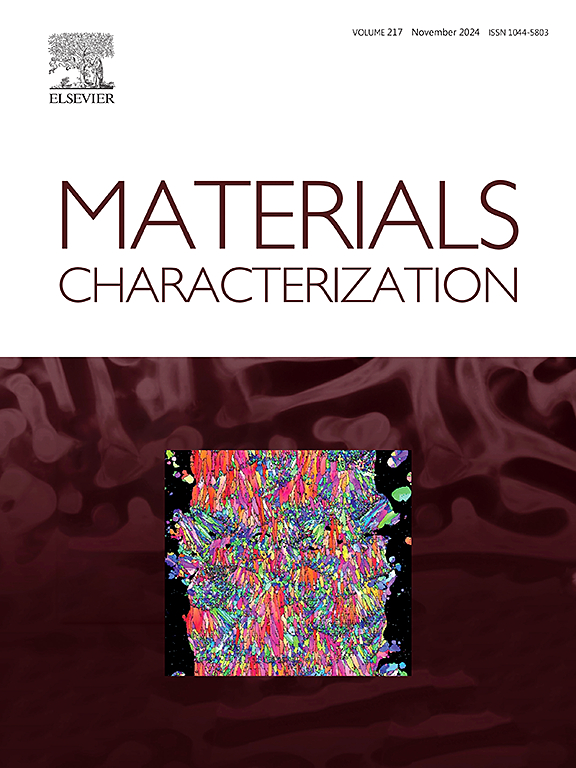通过激光粉末床熔接氮间隙和定制显微组织制备出强韧的亚稳β钛合金
IF 4.8
2区 材料科学
Q1 MATERIALS SCIENCE, CHARACTERIZATION & TESTING
引用次数: 0
摘要
亚稳态β型Ti-10 V-2Fe-3Al (Ti1023)合金由于其优异的力学性能,激光粉末床熔接(L-PBF)越来越受到人们的关注。在本研究中,采用Ar和10 vol% N₂的反应气氛来调整组织,并通过间隙氮原子实现固溶体强化,从而显著提高亚稳β -钛合金的力学性能。通过XRD (x射线衍射)确定,钛基体中的间隙氮原子诱导晶格畸变,而氮含量可达到~ 1900 ppm(百万分之一)。在Ar-10 vol% N₂反应气氛下,不同的扫描速度能显著促进Ti1023合金柱状向等轴转变(CET)和晶粒细化。透射电子显微镜(TEM)显示,纳米尺度的点状α相广泛成核和生长,这与间隙氮原子引起的Tβ温度升高和更强烈的热循环有关。力学试验表明,在纯Ar气氛下,随着扫描速度的增加,屈服强度从935.5±33.2 MPa降低到903.0±13.0 MPa,延伸率从6.4±3.1%提高到13.8±1.5%。相反,在10 vol% N₂气氛下,屈服强度从1053.0±18.0 MPa下降到986.3±7.6 MPa,塑性从5.8±1.1%增加到10.1±1.7%。间隙氮原子对屈服强度的贡献为~ 100mpa。纳米级ω和α相抑制了TRIP(相变诱导塑性)效应,从而防止了低屈服强度的出现。细小等轴晶粒形成的促进保持了合金的延展性。这种平衡导致强度和延展性的最佳组合。综上所述,本研究为调整亚稳β -钛合金的显微组织和提高其力学性能提供了一条途径。本文章由计算机程序翻译,如有差异,请以英文原文为准。

Strong and ductile metastable β titanium alloy via laser powder bed fusion through nitrogen interstitials and tailored microstructure
Owing to the excellent mechanical properties, the laser powder bed fusion (L-PBF) of metastable β-type Ti-10 V-2Fe-3Al (Ti1023) alloys has attracted increasing attention. In this study, an Ar and 10 vol% N₂ reactive atmosphere was employed to tailor the microstructure and achieve solid solution strengthening via interstitial nitrogen atoms, thereby significantly enhancing the mechanical properties of metastable β‑titanium alloys. Interstitial nitrogen atoms in the titanium matrix induce lattice distortion, as determined by XRD (X-ray diffraction), whereas the nitrogen content can reach ∼1900 ppm (parts per million). Under an Ar-10 vol% N₂ reactive atmosphere, various scanning speeds can notably promote the columnar to equiaxed transition (CET) and grain size refinement in Ti1023 alloys. Transmission electron microscopy (TEM) reveals extensive nucleation and growth of nanoscale, dot-like α phases, which correlates with the increased Tβ temperature and more intense thermal cycling induced by interstitial nitrogen atoms. Mechanical testing shows that, the increasing scanning speed under a pure Ar atmosphere reduces yield strength from 935.5 ± 33.2 MPa to 903.0 ± 13.0 MPa and increases elongation from 6.4 ± 3.1 % to 13.8 ± 1.5 %. Conversely, under a 10 vol% N₂ atmosphere, yield strength decreases from 1053.0 ± 18.0 MPa to 986.3 ± 7.6 MPa and ductility increases from 5.8 ± 1.1 % to 10.1 ± 1.7 %. Interstitial nitrogen atoms contribute ∼100 MPa to the yield strength. Nanoscale ω and α phases suppress the TRIP (transformation-induced plasticity) effect, thereby preventing the emergence of low yield strength. The promotion of fine equiaxed grain formation preserved the alloy's ductility. This balance results in an optimal combination of strength and ductility. In summary, this study presents a pathway to tailor the microstructure and enhance the mechanical properties of metastable β‑titanium alloys.
求助全文
通过发布文献求助,成功后即可免费获取论文全文。
去求助
来源期刊

Materials Characterization
工程技术-材料科学:表征与测试
CiteScore
7.60
自引率
8.50%
发文量
746
审稿时长
36 days
期刊介绍:
Materials Characterization features original articles and state-of-the-art reviews on theoretical and practical aspects of the structure and behaviour of materials.
The Journal focuses on all characterization techniques, including all forms of microscopy (light, electron, acoustic, etc.,) and analysis (especially microanalysis and surface analytical techniques). Developments in both this wide range of techniques and their application to the quantification of the microstructure of materials are essential facets of the Journal.
The Journal provides the Materials Scientist/Engineer with up-to-date information on many types of materials with an underlying theme of explaining the behavior of materials using novel approaches. Materials covered by the journal include:
Metals & Alloys
Ceramics
Nanomaterials
Biomedical materials
Optical materials
Composites
Natural Materials.
 求助内容:
求助内容: 应助结果提醒方式:
应助结果提醒方式:


